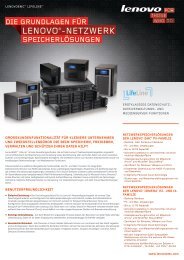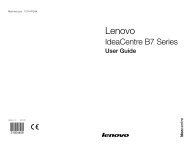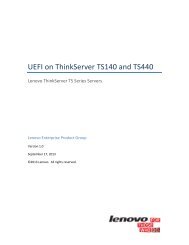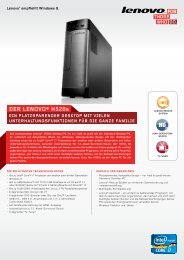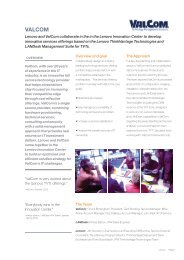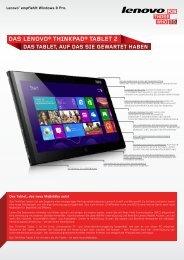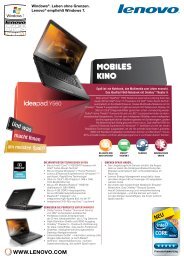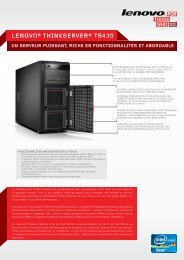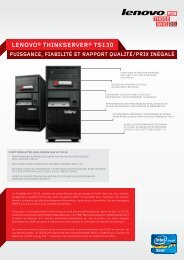Create successful ePaper yourself
Turn your PDF publications into a flip-book with our unique Google optimized e-Paper software.
• Recording and playback of PCM and WAV files in 16-bit or 24-bit format.<br />
• Playback of a WAV file at a sample rate of 44.1KHz to 192 KHz.<br />
• Playback of MIDI files through a Wave table synthesizer under Microsoft Windows operating systems.<br />
• Playback of MP3 files through the Windows Media Player or a software MP3 player.<br />
• Recording from various sound sources, such as a headset attached either to the combo audio jack of<br />
your computer or to the microphone jack of the ThinkPad Mini Dock Series 3 or the ThinkPad Mini<br />
Dock Plus Series 3.<br />
Note: The combo audio jack does not support a conventional microphone.<br />
The following table shows which functions of the audio devices attached to the jacks on your computer or<br />
docking station are supported.<br />
Table 3. Audio feature list<br />
Jacks Headset with a 3.5 mm<br />
4-pole plug<br />
Combo audio jack Headphone and<br />
microphone functions<br />
supported<br />
Headphone jack of the<br />
docking station<br />
Microphone jack of the<br />
docking station<br />
Beam Forming feature<br />
Only headphone function<br />
supported<br />
Microphone function not<br />
supported<br />
Conventional headphone Conventional microphone<br />
Headphone function<br />
supported<br />
Headphone function<br />
supported<br />
Not supported<br />
Not supported<br />
Not supported Not supported Microphone function<br />
supported<br />
A built-in dual array digital microphone is mounted at the top of the display. Whereas a conventional<br />
single-element microphone captures sounds from all around, the built-in dual array digital microphone is<br />
designed to capture the sound from an exceptionally limited angle, through the combination of a specialized<br />
microphone array with a capability of digital signal processing. Therefore the microphone captures sounds<br />
from the area in front of the system clearly, but blocks out almost all the sounds from outside the capturing<br />
range. Thus the speech of a user sitting in front of the system is input to the system without interference<br />
from noise in the surrounding area. To record your speech most clearly, you should speak directly in front<br />
of the computer.<br />
Configuring for sound recording<br />
To configure the microphone for optimized sound recording, open the SmartAudio window as follows:<br />
For Windows 7 and Windows Vista: Click Start ➙ Control Panel ➙ Hardware and Sound ➙ SmartAudio.<br />
The SmartAudio window opens.<br />
For Windows XP: Click Start ➙ Control Panel. Switch to Classic View and click SmartAudio. The<br />
SmartAudio window opens.<br />
Using an integrated camera<br />
If your computer has an integrated camera, when you press Fn+F6 to open the Communications settings<br />
window, the camera will be launched and the green camera-in-use indicator will turn on automatically. In<br />
the Communications settings window, you can preview your video image and take a snapshot of your<br />
current image.<br />
78 <strong>User</strong> <strong>Guide</strong>





